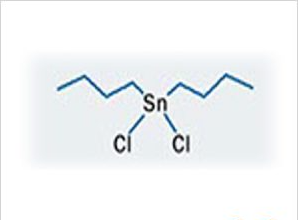Overview.
Product Name: Dibutyldichlorotin,CAS 683-18-1,dichlorodibutyltin,dichlorodibutyltin,dibutyltin chloride,Dibutyldichlorotin

Product Code: DBTC
Dibutyldichlorotin CAS 683-18-1 Dichlorodibutyltin Dichlorodibutyltin Dibutyltin chloride
Dibutyldichlorotin CAS 683-18-1 dichlorodibutyltin dichlorodibutyltin dibutyltin chloride
Basic information.
Chinese name:Dibutyltin dichloride
English name:Dibutyltin dichloride
Chinese Alias:Dichlorodibutyltin; Dibutyltin dichloride; Dichlorodibutyltin; Dibutyltin; Di-n-butyltin dichloride
English Alias:Dibutyldichlorotin; CAS No.:683-18-1 Molecular formula:C8H18Cl2Sn Molecular weight:303.8445 Dibutyldichlorotin CAS 683-18-1 Dichlorodibutyltin Dichlorodibutyltin Dibutyltin chloride Principal uses. Yellow viscous liquid with a peculiar odour, insoluble in water It can be used as a pharmaceutical intermediate, and can also be used to synthesize dibutyltin thiol with mercaptoester, and can react with caustic soda to form dibutyl oxide. Used in organic synthesis, catalysts for polymerization, organotin intermediates. Chinese name dibutyltin dichloride English name Dibutyltin dichloride Alias dichlorodibutyltin; dibutyltin dichloride CAS Registry Number 683-18-1 Physical properties data. Properties: Corrosive white pulpy substance. Density (g/mL,25/4°C): 1.36 Relative vapour density (g/mL,air=1): not determined Melting point(ºC):39-41 Boiling point (ºC, atmospheric pressure): not determined Boiling point (ºC,5.2kPa): not determined Refractive index: not determined Flash point (ºC): not determined Specific rotation (º): not determined Self-ignition or ignition temperature (ºC): not determined Vapour pressure (kPa,25ºC): not determined Saturated vapour pressure (kPa,60ºC): not determined Heat of combustion (KJ/mol): not determined Critical temperature (ºC): not determined
Critical pressure (KPa): not determined Logarithmic value of the oil-water (octanol/water) partition coefficient: not determined Storage and transport. Store in a sealed container in a cool, dry place. The storage area must be locked and the key must be given to the technical experts and their assistants for safekeeping. Storage must be away from oxidising agents and away from water sources. Transport: loading and unloading should be done lightly, breakage of the packaging should be prohibited during transport, any breakage found should be sealed immediately and trace amounts of leaking material diluted with large amounts of alkaline water. Packing. Packaging: Glass containers, plastic containers, metal vessels resistant to chlorine corrosion are suitable and should be kept in sealed containers. Store in a cool, dry place, keep container sealed and avoid contact with oxides.
Do not breathe dust, avoid contact with skin and mucous membranes. Smoking, eating and drinking are prohibited in the workplace. After work, shower and dressing. Store contaminated clothing separately, wash and reuse. Maintain good hygiene practices.


Comments